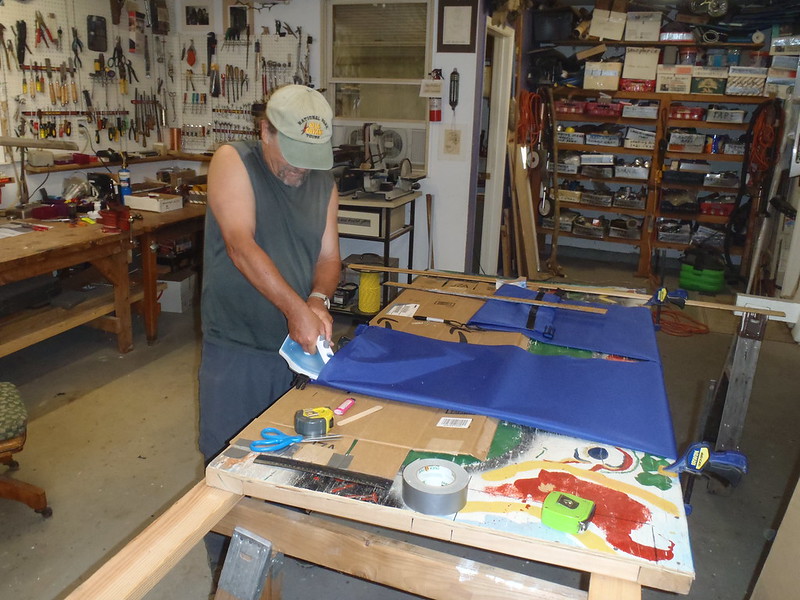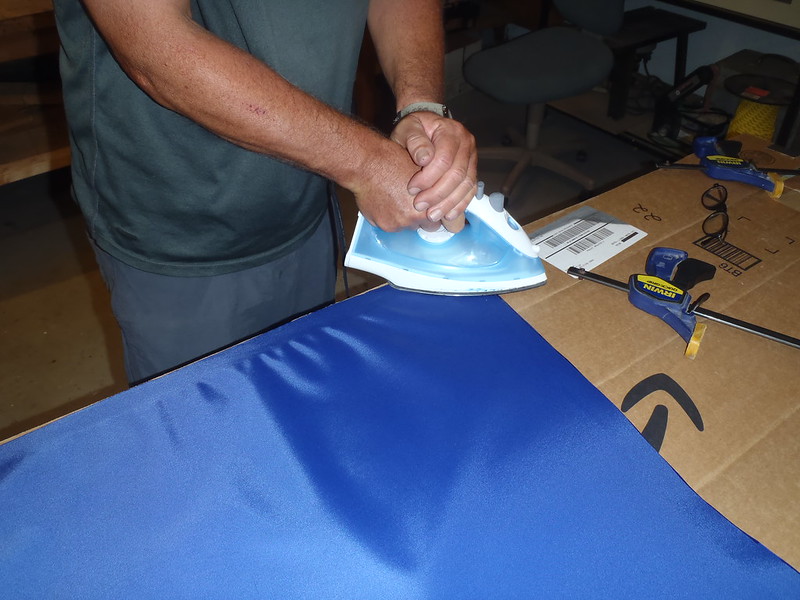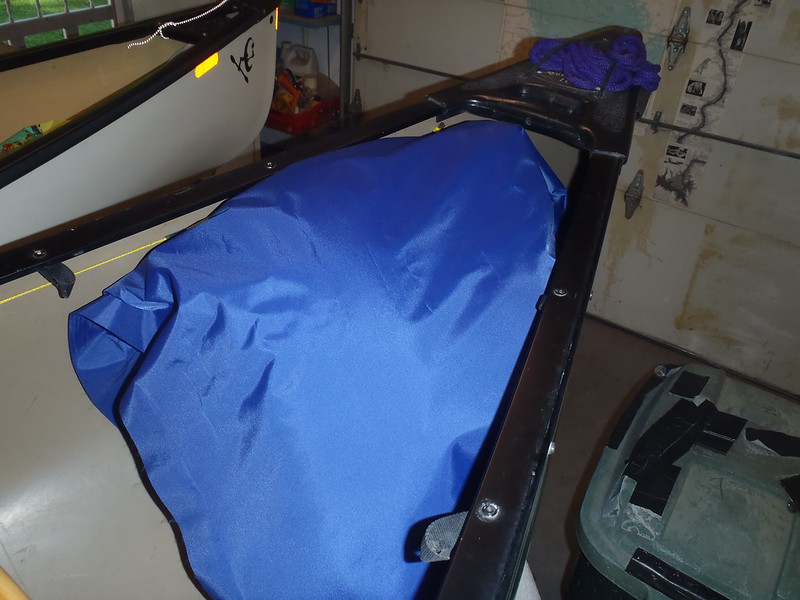G
Guest
Guest
I had the pleasure of guide friend Joel in the shop, without the usual trailer full of boats to futz with. He did have a T-Formex Esquif Cargo square stern on the roof racks; that one will eventually get a recessed fishing tackle and etc platform made to fit. But we had other plans for the day.
Joel did not have his Sawyer Loon. But I had some blue heat sealable pack cloth left, and saved the template for decked canoe tapered bags. Those bags proved to fit equally well in a variety of decked canoes, the Monarch, Optima, Comrade and Vagabond. Ought to fit his Loon just fine, and be useful in his more slender canoes.
It is always a memory challenge, even with the template as a guide for cutting out and ironing DIY dry bags. We only screwed up a little on the challenging top fold over on one bag, and managed to fix that one
Our usually, well practiced shop routine. I had everything laid out and ready to go when Joel arrrived; big cutting table, iron, squares and ironing fence board, clamps, scissors and Sharpie. Joel and I have worked together in the shop for many years, and I still haven’t learned him to put the cap back on the Sharpie. At this point I’d settle for him tossing the cap somewhere we could find.
 P9230002 by Mike McCrea, on Flickr
P9230002 by Mike McCrea, on Flickr
As also usual Joel did all the cutting, ironing and grunt work, I just worked ahead of him laying stuff out, and behind him putting stuff away, sometimes prematurely.
We go at it hard in the shop, non-stop, and it still took half a day to make two DIY tapered bags. Not many photos taken, we were busy. Dog eared corners, with grommets added later.
 P9240003 by Mike McCrea, on Flickr
P9240003 by Mike McCrea, on Flickr
Joel finished up with new scrap fabric wallet. He made a wallet from scrap the first time we ever made dry bags, gotta be close 10 years ago and he is still using it. If only his boats and tents held up that well. Everything we have made over the years; instrument bags, sleeping pad bags, chair bags and custom tapers, even the thinner Oxford cloth bags, are all still going strong.
 P9240007 by Mike McCrea, on Flickr
P9240007 by Mike McCrea, on Flickr
Tapered bags do use up a lot of material; the last of the blue pack cloth was just enough. Because of the shape making tapered bags leaves behind a lot of odd scrap.
 P9240005 by Mike McCrea, on Flickr
P9240005 by Mike McCrea, on Flickr
Well worth the effort though, a tapered kayak stem bag runs $60, and those skinny versions don’t fit for squat in a decked canoe. Those deck canoe tapers even fit OK in an open boat stem, including the soloized Penobscot.
 P9250013 by Mike McCrea, on Flickr
P9250013 by Mike McCrea, on Flickr
Not as well fitted as the open canoe stem tapers.
 P9250016 by Mike McCrea, on Flickr
P9250016 by Mike McCrea, on Flickr
Packed with lightweight stuff the capacity of a fitted stem bag in any shaped hull never ceases to amaze, and strapped in the bag provides at least some water occluding floatation.
I need to use some of that newly made scrap, the heat sealable fabric scrap box is overfull.
 P9250008 by Mike McCrea, on Flickr
P9250008 by Mike McCrea, on Flickr
Joel did not have his Sawyer Loon. But I had some blue heat sealable pack cloth left, and saved the template for decked canoe tapered bags. Those bags proved to fit equally well in a variety of decked canoes, the Monarch, Optima, Comrade and Vagabond. Ought to fit his Loon just fine, and be useful in his more slender canoes.
It is always a memory challenge, even with the template as a guide for cutting out and ironing DIY dry bags. We only screwed up a little on the challenging top fold over on one bag, and managed to fix that one
Our usually, well practiced shop routine. I had everything laid out and ready to go when Joel arrrived; big cutting table, iron, squares and ironing fence board, clamps, scissors and Sharpie. Joel and I have worked together in the shop for many years, and I still haven’t learned him to put the cap back on the Sharpie. At this point I’d settle for him tossing the cap somewhere we could find.
 P9230002 by Mike McCrea, on Flickr
P9230002 by Mike McCrea, on FlickrAs also usual Joel did all the cutting, ironing and grunt work, I just worked ahead of him laying stuff out, and behind him putting stuff away, sometimes prematurely.
We go at it hard in the shop, non-stop, and it still took half a day to make two DIY tapered bags. Not many photos taken, we were busy. Dog eared corners, with grommets added later.
 P9240003 by Mike McCrea, on Flickr
P9240003 by Mike McCrea, on FlickrJoel finished up with new scrap fabric wallet. He made a wallet from scrap the first time we ever made dry bags, gotta be close 10 years ago and he is still using it. If only his boats and tents held up that well. Everything we have made over the years; instrument bags, sleeping pad bags, chair bags and custom tapers, even the thinner Oxford cloth bags, are all still going strong.
 P9240007 by Mike McCrea, on Flickr
P9240007 by Mike McCrea, on FlickrTapered bags do use up a lot of material; the last of the blue pack cloth was just enough. Because of the shape making tapered bags leaves behind a lot of odd scrap.
 P9240005 by Mike McCrea, on Flickr
P9240005 by Mike McCrea, on FlickrWell worth the effort though, a tapered kayak stem bag runs $60, and those skinny versions don’t fit for squat in a decked canoe. Those deck canoe tapers even fit OK in an open boat stem, including the soloized Penobscot.
 P9250013 by Mike McCrea, on Flickr
P9250013 by Mike McCrea, on FlickrNot as well fitted as the open canoe stem tapers.
 P9250016 by Mike McCrea, on Flickr
P9250016 by Mike McCrea, on FlickrPacked with lightweight stuff the capacity of a fitted stem bag in any shaped hull never ceases to amaze, and strapped in the bag provides at least some water occluding floatation.
I need to use some of that newly made scrap, the heat sealable fabric scrap box is overfull.
 P9250008 by Mike McCrea, on Flickr
P9250008 by Mike McCrea, on Flickr


